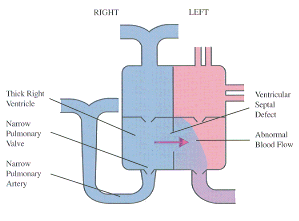
| Tetralogy of Fallot |
|
|
Down's Heart Group P.O. Box 4260 Dunstable, Beds, LU6 2ZT, United Kingdom Tel. & Fax: 0845 166 8061 E-mail: info@dhg.org.uk On-line community: http://groups.yahoo.com/group/Downs-Heart/ |
Reprinted with the permission of Penny Green, Director © 1998 Down's Heart Group UK Charity Nº 1011413 |

Diagram shows the heart looking from the front of the patient
The narrowing of the pulmonary (lung) artery makes it harder to get blood to the lungs, so the right ventricle has a much harder task than normal. Usually the pressure on the left is about four times greater that the right, but due to the increase resulting from the difficulty in pumping blood to the lungs, the right ventricle pressure becomes such that it is able to pump blood through the ventricular septal defect (VSD) and into the left ventricle as well as trying to fill the lungs.
Because of the high pressure in the right ventricle, the muscle becomes overdeveloped and thickens. All of these problems result in unoxygenated blood which has already been around the body, being diverted from the lungs where it should be going to collect oxygen, to the aorta and back around the body again. Thus the blood circulation to the body carries insufficient oxygen.
Symptoms
Initially there may be very little to suggest a problem other than a heart murmur, but gradually blueness (cyanosis) and breathlessness will appear. This may first be noticed when the baby cries or tires itself with exertion. Other children will experience 'blue spells' when the child may cry as though in discomfort, breathe quickly and become bluer than usual, and they may even go off to sleep (almost like a slow faint). If this happens it is important to reassure the child by cuddling them. and their circulation can be improved by getting them into a squalling position with their knees on their chest.
Treatment
Drugs may be given to help reduce these 'spells', but surgery will be needed eventually in all cases. For some children, it will be possible to have one operation during which the VSD is repaired and the narrowing in the pulmonary artery removed. Others, particularly smaller children or those where the pulmonary (lung) arteries are very small due to the lack of blood flow, will require palliative (helping) surgery before the complete repair.
Palliative surgery may lake the form of a shunt, in which the surgeon takes an artery that goes lo the arm and diverts it to the lungs instead, thus increasing the blood flow to the lungs which makes the child less cyanosed (blue) and not so breathless. The arm circulation continues through other branches. In some children it may be possible to insert a 'balloon' into the narrowed pulmonary artery (by way of a catheter) and by inflating the balloon. stretch the narrowed portion. Both procedures are temporary measures, and corrective surgery will be necessary at a later date.
Follow Up Advice
All children will require antibiotic cover during any denial treatment to prevent any bacteria entering the blood stream from where they can reach the heart causing bacterial endocarditis (infection of the heart lining), which can be very serious.
"We were devastated by the seriousness of his heart condition when it was fully explained, and it was a shock to think that it had been six months before we realised how dangerous those blue spells were. He did well to he hack on the ward after just a week in Intensive Care, and three months after surgery he was taken off all medications, and all is well."
| Revised: December 19, 2005. |